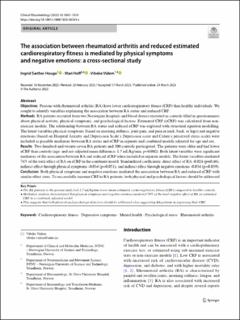| dc.contributor.author | Houge, Ingrid Sæther | |
| dc.contributor.author | Hoff, Mari | |
| dc.contributor.author | Videm, Vibeke | |
| dc.date.accessioned | 2024-01-02T08:48:17Z | |
| dc.date.available | 2024-01-02T08:48:17Z | |
| dc.date.created | 2023-04-12T10:14:10Z | |
| dc.date.issued | 2023 | |
| dc.identifier.citation | Clinical Rheumatology. 2023, . | en_US |
| dc.identifier.issn | 0770-3198 | |
| dc.identifier.uri | https://hdl.handle.net/11250/3109241 | |
| dc.description.abstract | Objectives
Persons with rheumatoid arthritis (RA) have lower cardiorespiratory fitness (CRF) than healthy individuals. We sought to identify variables explaining the association between RA status and reduced CRF.
Methods
RA patients recruited from two Norwegian hospitals and blood donors recruited as controls filled in questionnaires about physical activity, physical symptoms, and psychological factors. Estimated CRF (eCRF) was calculated from non-exercise models. The relationship between RA status and reduced eCRF was explored with structural equation modelling. The latent variables physical symptoms (based on morning stiffness, joint pain, and pain in neck, back, or hips) and negative emotions (based on Hospital Anxiety and Depression Scale’s Depression score and Cohen’s perceived stress scale) were included as possible mediators between RA status and eCRF in separate and combined models adjusted for age and sex.
Results
Two-hundred-and-twenty-seven RA patients and 300 controls participated. The patients were older and had lower eCRF than controls (age- and sex-adjusted mean difference: 1.7 mL/kg/min, p=0.002). Both latent variables were significant mediators of the association between RA and reduced eCRF when included in separate models. The latent variables mediated 74% of the total effect of RA on eCRF in the combined model. Standardized coefficients: direct effect of RA -0.024 (p=0.46), indirect effect through physical symptoms -0.034 (p=0.051), and indirect effect through negative emotions -0.034 (p=0.039).
Conclusion
Both physical symptoms and negative emotions mediated the association between RA and reduced eCRF with similar effect sizes. To successfully increase CRF in RA patients, both physical and psychological factors should be addressed. | en_US |
| dc.language.iso | eng | en_US |
| dc.publisher | Springer | en_US |
| dc.rights | Navngivelse 4.0 Internasjonal | * |
| dc.rights.uri | http://creativecommons.org/licenses/by/4.0/deed.no | * |
| dc.title | The association between rheumatoid arthritis and reduced estimated cardiorespiratory fitness is mediated by physical symptoms and negative emotions: a cross-sectional study | en_US |
| dc.title.alternative | The association between rheumatoid arthritis and reduced estimated cardiorespiratory fitness is mediated by physical symptoms and negative emotions: a cross-sectional study | en_US |
| dc.type | Peer reviewed | en_US |
| dc.type | Journal article | en_US |
| dc.description.version | publishedVersion | en_US |
| dc.source.pagenumber | 0 | en_US |
| dc.source.journal | Clinical Rheumatology | en_US |
| dc.identifier.doi | 10.1007/s10067-023-06584-x | |
| dc.identifier.cristin | 2140178 | |
| cristin.ispublished | true | |
| cristin.fulltext | original | |
| cristin.qualitycode | 1 | |

